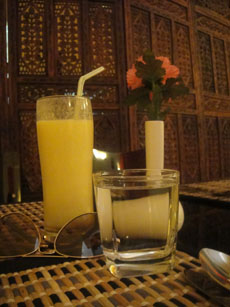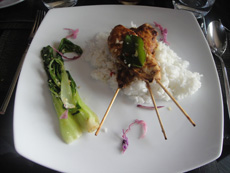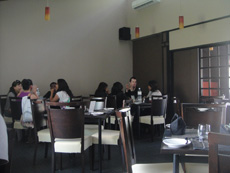Almost everywhere you look in Male’ you can see coffee shops. From cosy little places that barely seat 10, to trendy hangouts with sea views and prices quoted in dollars. The one thing that binds all these disparate establishments together, though, is their consistently bad coffee.
The most common outing in Male’ is going out for coffee. Lavazza, Melitta, Danesi, Illy, the names rolls off local tongues as easily as yellow fin or skip jack. On a few occasions, you might be served a good cuppa. But this happens so rarely you might be forgiven for thinking it a freak accident, in which the barista was distracted by a shooting star and forgot to burn the coffee beans.
Are Maldivians addicted to burnt coffee, or is the lack of entertainment so severe, that sipping bad coffee in good company is better then sitting cooped up in your room? The latter seems most probable; coffee shop regulars complain non-stop about poor food and drink. However, like the English, we Maldivians are loath to return bad drinks, meaning eateries continue to serve rubbish and get away with it.
When Maldivians visit resorts or travel to foreign countries, we are generally discerning customers, able to tell the difference between a good cup of coffee and a burnt one. Alas! The dearth of good Male’ cafés has condemned local denizens to make do with what is on offer.
Here we offer a few examples of Male’s consistently bad coffee drinking experience:
You might assume that a café called Shell Beans would know how to make coffee. You would be mistaken. The trendy water front café frequented by Male’s ‘it crowd’ use expensive imported coffee machines for their brews. When we order cappuccino, though, they arrive as a brown soupy liquid with a scum of discoloured bubbles on top. The coffee is burnt and foul.
Next we try Shell Bean’s namesake, a new establishment called Coffee House. The café is more akin to London or San Francisco than Male’. Floor to ceiling glass windows, comfy chairs and cool wallpaper give this place a fresh, funky feel. The interior might lift the spirits but the coffee dispirits the soul. Those that inhabit the house know not how to make coffee. Our cappuccino arrives burnt, revolting and utterly undrinkable.
One of the most visible cafes in the capital is Panini, in the lobby of Male’s swanky Trader’s Hotel. In Trader’s previous incarnation as Holiday Inn, Panini was an oasis of a café, where you were always guaranteed a well-rounded, good coffee.
When Holiday Inn sold the hotel to Shangri-La’s Trader’s brand, we rejoiced. After all Shangri-La is a leading luxury hotel brand in Asia, renowned for its gastronomy. But reputation does not match reality. Nowadays, Panini’s coffee is hit and miss. Our filter coffee arrives looking as black as the devil, and strong enough to fill your week’s caffeine quota in one cup.
Our latte, by contrast, looks almost angelic in its pale, milky appearance. It’s a perfect drink for those craving a warm glass of milk, but café latte it is not. Panini is a good example of how different people can make wildly different coffee from the same machine.
There is one member of Panini’s staff – a hangover from the Holiday Inn days – who makes perfect coffee. So to get a decent cup, you must stalk the lobby and wait for this lady’s shift to start. It seems she is the only server who knows her way around the Nuova Simonelli coffee machine.
In our quest for a drinkable coffee, we splash out on a meal at Sala Italia, one of the city’s most expensive restaurants. We order cappuccino. What arrives borders on the bizarre: an espresso cup with a shot of espresso and another of milk, with about a dozen bubbles on top.
“What on earth is this?” we ask.
“Espresso-Cappuccino,” says the waiter.
A lack of training, or maybe the right cup, has spawned a new breed of coffee. We send it back in exchange for (perfectly prepared) filter coffee. It seems even in an Italian restaurant, few know much about coffee.
The problem of Male’s poor coffee does not lie in the expensive machines or the well-sourced beans most cafes seem to have. It is the know-how that is missing. The essence of making a good cup seems an anathema to most cafes: clean the coffee machine regularly; don’t re-heat the same water over and over again; heat the milk only when an order is placed; use fresh milk not powdered; and above all make sure the water is heated to the right temperature so the coffee isn’t bitter.
In a desperate, last ditch attempt to find good coffee, we head off to one of the Maldives’ most exclusive resorts. We are sitting on the beach at Soneva Gili, sipping the perfect cappuccino; well-roasted Arabica beans, blended perfectly, with a good half inch of creamy foam on top. At US$8 the coffee is pretty good value but to do this again, we would have to stump up US$1,200 per night for the room charge. At US$1,208 per cup, this is an expensive cappuccino.
After three months touring the capital in the quest for the perfect cup of coffee we have drawn a blank. The only way to guarantee good coffee is to head off to a resort. A cheaper option might be to go to the travel agents and book a flight to Rome.
All review pieces are the sole view of the author/s and do not reflect the editorial policy of Minivan News. If you would like to write an opinion piece, please send proposals to [email protected]
Likes (0)Dislikes
(0)Dislikes (0)
(0)
 (0)Dislikes
(0)Dislikes (0)
(0)



